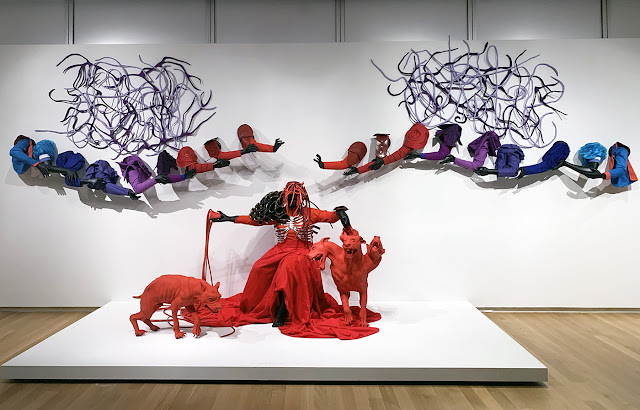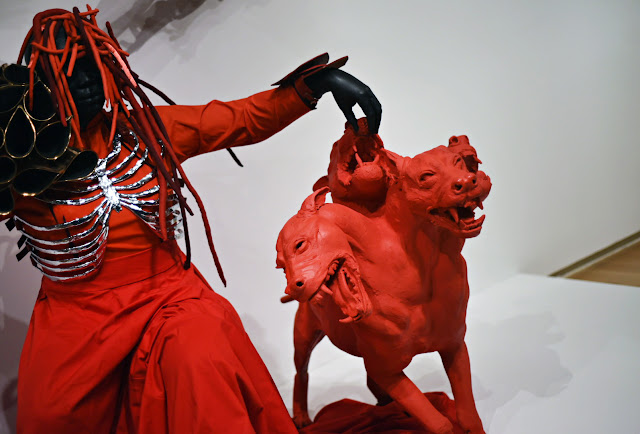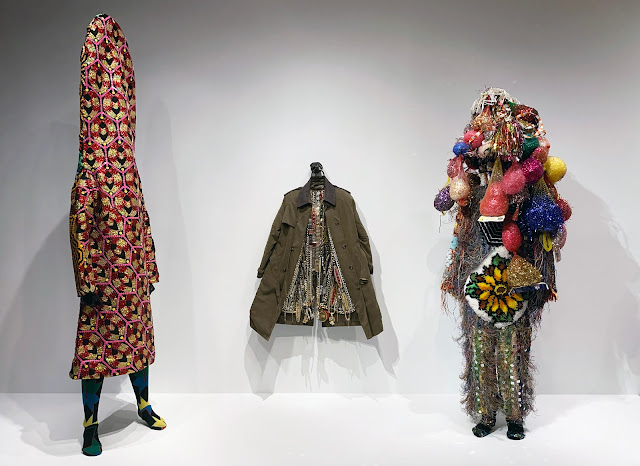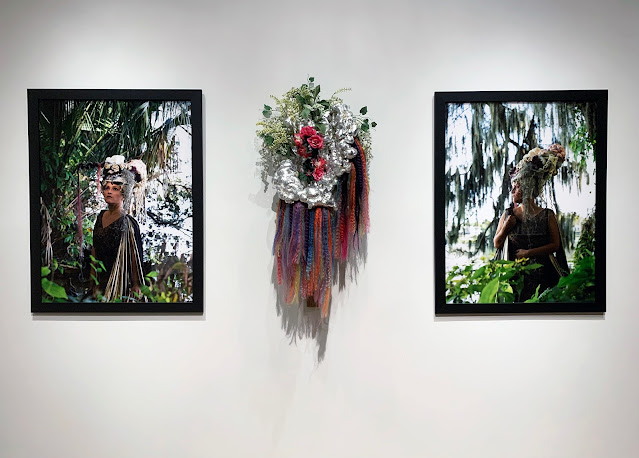Mary Sibande The Domba Dance (2019) for Garmenting: Costume as Contemporary Art @MADMuseum
Garmenting as art vs. apparel has been debated for decades. Often an amalgam of both, 'clothes' are a malleable medium for all--whether creative, conservative or curious. Materials, manufacturing or meaning can transform the purpose of a single item of clothing. MAD Museum's Garmenting: Costume as Contemporary Art is the first global survey of clothing as a form of visual art. Curated by Alexandra Schwartz, the exhibit features over 60 works from 35 artists and occupies the 4th and 5th floors of MAD. Up close, each garment in this exhibition--wacky or wearable--appeals to the imagination. Click for a look inside...
With the notion that "Adopted globally as an artistic strategy, garmenting uses the language of fashion to challenge traditional divisions of form and function, cast a critical eye on the construction of gender, advance political activism and address cultural difference," the space is divided into five categories: Functionality, Cultural Difference, Gender, Activism, Performance Art. Contrary to fashion exhibits that showcase a collection of works by a solo artist or a group show under a singular guise, the cautiously curated garments in this exhibit stand alone as artistic centerpieces--each with a unique story.
Devan Shimoyama February II (2019); This piece--named for the month of Trayvon Martin's birth--is a tribute to his innocence.
My experience begins on the 5th floor, where a global history of garmenting provides pretext for the presented pieces. 'Functionality' explores form vs. fashion and flows comfortably into the emotionally charged components of 'Cultural Difference.' Three standouts for me:
1. Devan Shimoyama's silk floral hoodie with rhinestone hood (entitled February II) pays tribute to the innocence of Trayvon Martin. Trayvon was shot wearing a hoodie and the flowers symbolize the bouquets often left at memorial sites. Hung high up, with arms outstretched, the form resembles a crucifix, or an angel floating in heaven...
2. Nick Cave's trio of sculptural styles conceal visual identifiers of gender and race. Toying with the thought that dress can disguise or protect (alluding to the evolution of 'garment' from 'garner' which means 'to protect'/ 'to armor'), Cave's first Soundsuit was crafted in response to the 1991 beating of Rodney King. Cave's Hustle Coat alludes to the peddling of counterfeit product, and the need to quickly conceal items in an approach of law enforcement.
3. Nazareth Pacheco's Untitled appears to embody a sexy, see-through miniskirt. A closer look may uncover the subtle fringe of scalpels lining the bottom hem. This intricately crafted garment, hints at the physical and psychological violence that may come with seduction and femininity.
Close up of Mary Sibande's The Domba Dance
The exhibit continues on the 4th floor with 'Gender,' 'Activism' and ultimately ending with an area reserved for 'Performance Art.' The three standouts for me here are:
1. Qendrim Hoti and Esmaa Mohamoud's Untitled (from "One of the Boys")--a striking combination of Vince Carter jerseys atop ballroom style hoop skirts--was worn by both Male and Female models (e.g. gender fluidity). Hoti and Mohamoud's creations challenge gender norms and expectations (e.g. basketball is often viewed as a means of success in Black culture, though very few make it to the NBA).
2. Zoe Buckman's installation speaks to femininity and the contradictory / complementary elements of the hip hop songs she grew up with. Originally entitled "Every Curve" (2016), vintage lingerie is emblazoned with hand embroidered lyrics and serve as both tribute and critique.
3. Sheelasha Rajbhandar's My Great-Grandmother's Shawl speaks to the evolution of textile production-- once entirely handmade, but now mostly mass-produced.
Garmenting: Costume as a Contemporary Art is open to the public until August 14, 2022. If you visit, take your time and read the captions!
Nick Cave [L] Soundsuit (2018), [M] Hustle Coat (2017), [R] Soundsuit (2006); Sculptural garments that conceal visual identifiers (e.g. race, gender, etc.). The first of these were originated in response to the Rodney King beating in 1991.
Close up of Soundsuit (2006)
Tanis S'eitlin, Untitled (2017); This work pays homage to the Tlingit tribe
Fifth floor installation view of global garmenting history
[L] Vivian Sundaram Hair (2011), [M] Louise Bourgeois Blue Days (1996) includes 7 vintage dresses from the artist's personal wardrobe
Wanda Raimundi-Ortiz Wig Variant #4 (for Milo) (2021); This piece focuses on the cultural and personal significance of hair.
Installation view - 'Functionality' section
Installation of items from Franz Erhard Walther
Nazareth Pacheco Untitled (2000); Lace like garment with razor fringe
Close up of the super sharp 'scalpel fringe'
Installation view of the 4th Floor entryway
Installation view- 'Gender' section
Zoe Buckman, [L] Bitch Again (2016), [R] Do We Hate Our Women (2016)
Installation view Zoe Buckman pieces (2014-2016); Vintage lingerie hand-embroidered w/ lyrics from hip hop songs
Andrea Zittel [L] A-Z Smockshop Uniform: Fall 2007 (2007) + [R] A-Z Smockshop Uniform: Winter 2007-2008 (2007-08)
Saya Woolfalk ChimaCloud
Raul de Nieves Celebratory Skin / Knowledge (2019);
Installation view - 'Activism' Section
Jeffrey Gibson The Anthropophagic Effect, Garment no.4 (2019)
[L] Close up of Jeffrey Gibson's The Anthropophagic Effect, Garment no. 4 | [R] Close up of Jakkai Siributr's Blind Faith military uniform
Installation view - 'Activism' section
Sheelasha Rajbhandari My Great-Great-Grandmother's Shawl (2017)



























No comments:
Post a Comment